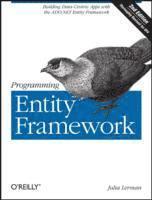
- Format
- Häftad (Paperback)
- Språk
- Engelska
- Antal sidor
- 873
- Utgivningsdatum
- 2010-09-01
- Upplaga
- 2 Rev ed
- Förlag
- O'REILLY & ASSOCIATES
- Illustrationer
- illustrations
- Dimensioner
- 234 x 178 x 48 mm
- Vikt
- Antal komponenter
- 1
- ISBN
- 9780596807269
- 1430 g
Programming Entity Framework 2nd Edition
- Skickas från oss inom 5-8 vardagar.
- Fri frakt över 249 kr för privatkunder i Sverige.
Passar bra ihop
De som köpt den här boken har ofta också köpt Python Crash Course, 3rd Edition av Eric Matthes (häftad).
Köp båda 2 för 1092 krKundrecensioner
Fler böcker av Julia Lerman
-
Programming Entity Framework - Code First
Julia Lerman
-
Programming Entity Framework: DbContext
Julia Lerman
-
Programming Entity Framework: Code First
Julia Lerman, Rowan Miller
-
Programming Entity Framework
Julia Lerman
Övrig information
Julia Lerman is the leading independent authority on the Entity Framework and has been using and teaching the technology since its inception two years ago. She is well known in the .NET community as a Microsoft MVP, ASPInsider and INETA Speaker. She is a prolific blogger, a frequent presenter at technical conferences around the world, including DevConnections and TechEd and she writes articles for many well-known technical publications. Julia lives in Vermont where she runs the Vermont.NET User Group, is a board member of the Vermont Software Developers Alliance, and a member of the Champlain College Software Engineering Advisory Board. You can read her blogs at www.thedatafarm.com/blog.
Innehållsförteckning
Foreword; Preface; Who This Book Is For; How This Book Is Organized; What You Need to Use This Book; This Books Website; Conventions Used in This Book; Using Code Examples; Safari Books Online; Comments and Questions; Acknowledgments; Author Note for Third Printing, August 2011; Entity Framework 4.1 (Code First and DbContext) Has Released; Entity Framework June 2011 CTP; Chapter 1: Introducing the ADO.NET Entity Framework; 1.1 The Entity Relationship Model: Programming Against a Model, Not the Database; 1.2 The Entity Data Model: A Client-Side Data Model; 1.3 Entities: Blueprints for Business Classes; 1.4 The Backend Database: Your Choice; 1.5 Entity Framework Features: APIs and Tools; 1.6 The Entity Framework and WCF Services; 1.7 What About ADO.NET DataSets and LINQ to SQL?; 1.8 Entity Framework Pain Points Are Fading Away; 1.9 Programming the Entity Framework; Chapter 2: Exploring the Entity Data Model; 2.1 Why Use an Entity Data Model?; 2.2 The EDM Within the Entity Framework; 2.3 Walkthrough: Building Your First EDM; 2.4 Inspecting the EDM in the Designer Window; 2.5 The Models Supporting Metadata; 2.6 Viewing the Model in the Model Browser; 2.7 Viewing the Models Raw XML; 2.8 CSDL: The Conceptual Schema; 2.9 SSDL: The Store Schema; 2.10 MSL: The Mappings; 2.11 Database Views in the EDM; 2.12 Summary; Chapter 3: Querying Entity Data Models; 3.1 Query the Model, Not the Database; 3.2 Your First EDM Query; 3.3 Querying with LINQ to Entities; 3.4 Querying with Object Services and Entity SQL; 3.5 Querying with Methods; 3.6 The Shortest Query; 3.7 ObjectQuery, ObjectSet, and LINQ to Entities; 3.8 Querying with EntityClient to Return Streamed Data; 3.9 Translating Entity Queries to Database Queries; 3.10 Avoiding Inadvertent Query Execution; 3.11 Summary; Chapter 4: Exploring LINQ to Entities in Greater Depth; 4.1 Getting Ready with Some New Lingo; 4.2 Projections in Queries; 4.3 Projections in LINQ to Entities; 4.4 Using Navigations in Queries; 4.5 Joins and Nested Queries; 4.6 Grouping; 4.7 Shaping Data Returned by Queries; 4.8 Loading Related Data; 4.9 Retrieving a Single Entity; 4.10 Finding More Query Samples; 4.11 Summary; Chapter 5: Exploring Entity SQL in Greater Depth; 5.1 Literals in Entity SQL; 5.2 Projecting in Entity SQL; 5.3 Using Navigation in Entity SQL Queries; 5.4 Using Joins; 5.5 Nesting Queries; 5.6 Grouping in Entity SQL; 5.7 Shaping Data with Entity SQL; 5.8 Understanding Entity SQLs Wrapped and Unwrapped Results; 5.9 Summary; Chapter 6: Modifying Entities and Saving Changes; 6.1 Keeping Track of Entities; 6.2 Saving Changes Back to the Database; 6.3 Inserting New Objects; 6.4 Inserting New Parents and Children; 6.5 Deleting Entities; 6.6 Summary; Chapter 7: Using Stored Procedures with the EDM; 7.1 Updating the Model from a Database; 7.2 Working with Functions; 7.3 Mapping Funct...


